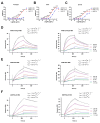Structure-Based Optimization of One Neutralizing Antibody against SARS-CoV-2 Variants Bearing the L452R Mutation
- PMID: 38675908
- PMCID: PMC11053997
- DOI: 10.3390/v16040566
Structure-Based Optimization of One Neutralizing Antibody against SARS-CoV-2 Variants Bearing the L452R Mutation
Abstract
Neutralizing antibodies (nAbs) play an important role against SARS-CoV-2 infections. Previously, we have reported one potent receptor binding domain (RBD)-binding nAb Ab08 against the SARS-CoV-2 prototype and a panel of variants, but Ab08 showed much less efficacy against the variants harboring the L452R mutation. To overcome the antibody escape caused by the L452R mutation, we generated several structure-based Ab08 derivatives. One derivative, Ab08-K99E, displayed the mostly enhanced neutralizing potency against the Delta pseudovirus bearing the L452R mutation compared to the Ab08 and other derivatives. Ab08-K99E also showed improved neutralizing effects against the prototype, Omicron BA.1, and Omicron BA.4/5 pseudoviruses. In addition, compared to the original Ab08, Ab08-K99E exhibited high binding properties and affinities to the RBDs of the prototype, Delta, and Omicron BA.4/5 variants. Altogether, our findings report an optimized nAb, Ab08-K99E, against SARS-CoV-2 variants and demonstrate structure-based optimization as an effective way for antibody development against pathogens.
Keywords: COVID-19; L452R mutation; neutralizing antibody; structure-based antibody optimization.
Conflict of interest statement
The authors declare no conflicts of interest.
Figures



Similar articles
-
A Spike-destructing human antibody effectively neutralizes Omicron-included SARS-CoV-2 variants with therapeutic efficacy.PLoS Pathog. 2023 Jan 27;19(1):e1011085. doi: 10.1371/journal.ppat.1011085. eCollection 2023 Jan. PLoS Pathog. 2023. PMID: 36706160 Free PMC article.
-
A human monoclonal antibody neutralizing SARS-CoV-2 Omicron variants containing the L452R mutation.J Virol. 2024 Dec 17;98(12):e0122324. doi: 10.1128/jvi.01223-24. Epub 2024 Nov 4. J Virol. 2024. PMID: 39494911 Free PMC article.
-
Epitope Classification and RBD Binding Properties of Neutralizing Antibodies Against SARS-CoV-2 Variants of Concern.Front Immunol. 2021 Jun 4;12:691715. doi: 10.3389/fimmu.2021.691715. eCollection 2021. Front Immunol. 2021. PMID: 34149735 Free PMC article.
-
Comprehensive mapping of binding hot spots of SARS-CoV-2 RBD-specific neutralizing antibodies for tracking immune escape variants.Genome Med. 2021 Oct 14;13(1):164. doi: 10.1186/s13073-021-00985-w. Genome Med. 2021. PMID: 34649620 Free PMC article.
-
Current Status and Perspectives of Therapeutic Antibodies Targeting the Spike Protein S2 Subunit against SARS-CoV-2.Biol Pharm Bull. 2024;47(5):917-923. doi: 10.1248/bpb.b23-00639. Biol Pharm Bull. 2024. PMID: 38692869 Review.
Cited by
-
SARS-CoV-2 Neutralizing Antibodies 2.0.Viruses. 2024 Nov 19;16(11):1791. doi: 10.3390/v16111791. Viruses. 2024. PMID: 39599905 Free PMC article.
References
Publication types
MeSH terms
Substances
Supplementary concepts
Grants and funding
- 2021YFE0200600/National Key Research and Development Program of China
- 82151215/National Natural Science Foundation of China
- Nos. 2019SHZDZX02, HS2021SHZX001/Shanghai Municipal Science and Technology Major Projects
- Nos. 22490760100, 23XD1404300,22ZR1468300/Science and Technology Commission of Shanghai Municipality
LinkOut - more resources
Full Text Sources
Medical
Miscellaneous

